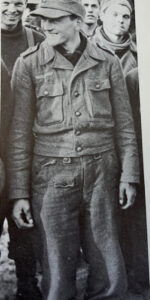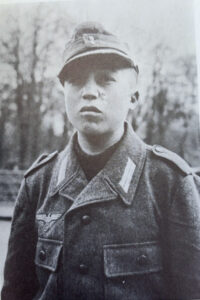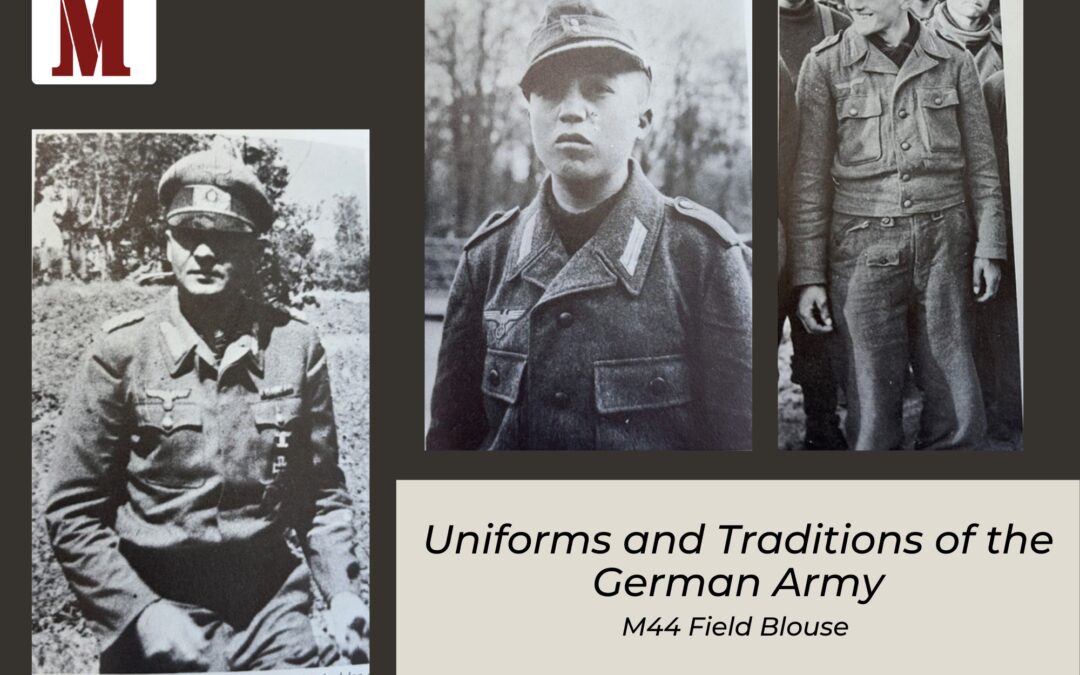Today, I would like to dive into the German WW2 Army Uniforms, focusing on a specific German Field Service Tunic – the German Model 44 Field Blouse. The following information comes from German Army Uniforms and Insignia 1933-1945 by Brian L. Davis. The pressure of economic war conditions against Germany resulted in the introduction, on 25th September 1944, of an entirely new style of Field Service Tunic – the Model 1944 (or M44) Field Blouse. This was a complete break with the German Army uniform tradition in so far as it was a new form of uniform jacket. The newly adopted style, which for all its radical design was similar to the British Army Battle Dress Blouse, did not retain any of the features of styling normally associated with the traditional German Service Uniform.

Image: The M44 Field Uniform. The ‘Felbluse’ was distinctive for its two unpleated breast pockets, wide waistband, and lack of ‘skirt’ to the jacket.
The color of this new uniform was more slate grey-green than field-grey and the most noticeable feature of the Field Blouse was the replacement of the jacket skirt with a waistband of 12 cm deep. Due to the lack of a skirt on the jacket, only two patch pockets were worn, both on the chest. Each was without pleats and each had a simple straight-edged pocket flap. The collar of the jacket was normally worn open, but it had provision to be closed. There were six metal buttons worn down the front, the lower two being positioned on the waistband. The cuffs were like the normal other ranks quality Service Tunics cut in such a way so they could be gathered in and buttoned to fit more closely around the wearer’s wrists. The back of the tunic was made from one unseamed piece of material. Metal belt hooks were used to hold up the belt and to help support the wearer’s equipment, the normal triple belt hook positions were reduced to only one position. There were two inside breast pockets, each closed with a single fiber button, but there was no field dressing pocket inside the blouse.

Image: 16-year old Grenadier Joseph Voss taken prisoner defending the German town of Lemgo. Clearly shown is the ‘economy’ pattern insignia used on the Modell 44 Field Blouse. The triangular National Emblem and the simplified mouse grey collar patches.
Normal shoulder straps of the wearer’s rank and his Waffenfarbe piping (the coloring system of uniform adornments to display rank and military unit) were worn, sometimes made from the same material as the jacket but often older pattern straps were worn. The collar was of the same material and color as the blouse and the late pattern mouse-grey collar patches were worn that did not show the wearer’s Waffenfarbe.
The M44 Field Blouse was issued to all ranks both in the German Army and the Waffen-SS (with the exception of Panzer crews) to be worn when existing stocks of the old Model 36, 41,42 and 43 patterns were exhausted. Non-commissioned officers did not normally wear any rank braid sewn around the edge of the collar, the only indication of rank being the shoulder straps. Generals, however, were permitted to wear their normal rank insignia including collar patches. In a future blog, I shall discuss more about the Model 44 uniforms

Image: Generalleutenant Graf von Schwerin, holder of the Knight’s Cross with Oakleaves and Swords, commanding Officer of the 76th Panzer Corps. Is shown wearing a Tailor made example of the M44 Field Blouse.
